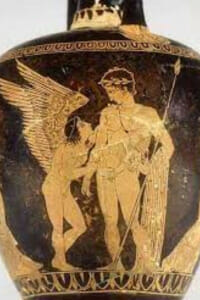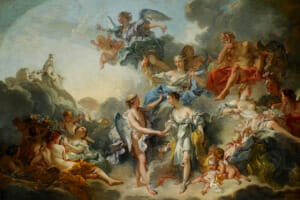Himeros: The God of Sexual Desire in Greek Mythology
 Himeros was one of the several gods that were linked to Erotes, a collection of winged gods of love and sexual practices. He is very famous for being the god of sexual desire in Greek mythology. Other than him, there are also his siblings who are associated with love, marriage, and lust.
Himeros was one of the several gods that were linked to Erotes, a collection of winged gods of love and sexual practices. He is very famous for being the god of sexual desire in Greek mythology. Other than him, there are also his siblings who are associated with love, marriage, and lust.
Here, in this article, we bring you all the information and clear insight about this Greek god and his siblings.
Who Was Himeros?
Himeros has one of the most explicit characters and storylines. Himeros is a part of a collection of gods and goddesses which are specifically related to sexual intercourse and everything that it entails. This group of gods and goddesses comes under Erotes, who was the leader of the group.
Origin of Himeros
There is a lot of controversy on the origin and the parentage of Himeros and this is because the sources give two stories behind the birth and life of Himeros. Here we look at both of them. Theogony by Hesiod was written in 700 Bc, which Hesiod claimed was the last of the Dark Times of Greek mythology. So for ages, Theogony has been the ultimate source for finding and studying the genealogy of all the gods, goddesses, and their legitimate and illegitimate children with mortals and immortal beings.
Theogony explains Himeros to be the son of Aphrodite. In Greek mythology, Aphrodite is the goddess of sexual love and beauty. Aphrodite bore Himeros and other siblings who were all then associated with different levels of sexual love and beauty.
In the same book, Hesiod also explains that Aphrodite and Himeros were born at the same time but Himeros is not her sibling of Aphrodite rather he is her son. This gets confusing here.
Physical Features of Himeros
Himeros is always shown as a man of older age with a muscular but lean body. He always wears white and is shown to be very handsome. Of course, he was the son of Aphrodite, he would be handsome and beautiful in every way.
Moreover, he is also shown to be holding a taenia which the athletes sometimes wear on their heads and is very colorful. Like the Roman god of love, Cupid, Himeros is also sometimes shown with an arrow and a bow, and a pair of wings are even drawn on his fit body.
Many different drawings and paintings of Aphrodite giving birth are present. In the paintings, Himeros is always shown alongside Eros, and the pair are seen with their mother Aphrodite; however, there is no sign of Ares anywhere in the paintings.
Characteristics of Himeros
Himeros was the god of sexual desires. He alongside his mother and siblings would put destructive desires in the minds and hearts of men. This desire would make them go crazy and do things that were out of their control. This ability to make men obedient to their wishes was very dangerous.
According to Hesiod, Aphrodite and her twins, Eros and Himeros did not only mingle in personal relationships with people but also meddled with state affairs and wars. Whatever results they wanted, they made it happen by whispering things in the ears of the men. Not only did it change the course of mortals but also messed with the lives of immortals on Mount Olympus.
This trio was unbreakable and unhinged. They only grew in number and so did their powers to control everyone and everything around them. All that we know about Himeros is in sync with Eros because the pair was inseparable and not much information is present about Himeros alone.
Himeros, Eros, and Aphrodite
In some parts of the myth, it is stated that Aphrodite was pregnant with twins. She bore two children, namely Eros and Himeros together. Aphrodite bore the twins as soon as she was born. The myth explains that Aphrodite was born from sea foam.
When she appeared in the sea, she was ready to give birth to the twins, Himeros and Eros. Both the twins were conceived in the same sea. They were inseparable. Aphrodite, Himeros, and Eros lived together and were each other’s family before any other came into their small circle. They never left each other’s side and always supported each other.
Himeros and Eros accompanied Aphrodite when she was to enter the gods’ den and stand in front of them. Aphrodite was the mother but who was the father? The literature sometimes points the finger toward Ares but no one can tell for sure if Ares is in fact the father of Eros and Himeros.
Himeros and His Siblings
According to literature, Aphrodite had eight children. These children were: Himeros, Eros, Anteros, Phanes, Hedylogos, Hermaphroditus, Hymenaios, and Pothos. These children were born to the goddess of sexual love and beauty which is why each of them was a god of something to love, sex, and beauty.
Himeros was closest to his twin sibling, Eros. The pair was then close to most of their siblings and there is no evidence of there ever being a conflict among the group of eight. We know that Himeros was the god of sexual desire but what were the specifications of his siblings? Let us read about each of Himeros siblings in detail:
Eros
Eros was the twin brother of Himeros and also among the first children of Aphrodite. He was the primordial god of love and intercourse and because of that, he was also the god of fertility. Among all the Erotes, Eros is probably the most well-known because of his abilities and powers over love, sex, and fertility.
Eros is mostly portrayed with an arrow and a bow. In paintings, he is always accompanied by Himeros, dolphins, roses, and light torches. He was the symbol of love and all of his siblings look up to him.
Anteros
Anteros was another important character in the Erotes and was the protector of mutual love. He punished anyone who betrayed true love or stood in the way of it. He was also known as the avenger of unrequited love and as the joiner of two hearts.
Anteros was as beautiful as the rest of the siblings. He had long straight hair and was always seen as a kind-hearted man when it came to love and caring. Instead of a bow and an arrow, he always held a golden club.
Phanes
Phanes was the god of creation and procreation. Even though Eres was the god of fertility, Phanes and Eros were not the same. It was at one point believed that Phanes was another form of Eros but that was untrue.
Phanes was the last addition to the pantheon but his powers were unlike any other. It is because of him that the generations of the immortals and mortals started and they ran as long as they did.
Hedylogos
Hedylogos was the god of flattery among the eight Erotes. He played the role of a wingman in many relations where the lovers were too shy to say the first word or to make the first move. He helped lovers to communicate their true feelings for each other.
Not much information is present about the looks of Hedylogos. Hedylogos, therefore, was an important deity in the Erotes and was very well-known.
Hermaphroditus
He is the god of Androgyny and Hermaphroditism. Hermaphroditus has the most interesting story among the eight Erotes. It has been mentioned that he was born as a son to Aphrodite and Zeus, not Ares. He was born as the most beautiful boy the world had ever seen so a water nymph fell in love with him.
The water nymph asked the gods to let her be with him and to unite their bodies in one and so they did. This is the reason why Hermaphroditus has both parts of females and males. Their upper body has male features with female breasts, and a female waist and the lower body has female buttocks and male parts.
Hymenaios
Hymenaios was the god of wedding festivities and ceremonies. He was in charge of making sure that everything at the wedding went on smoothly, and that nothing was causing any trouble. He was also responsible for securing lifelong happiness for the groom and the bride along with a fruitful wedding night.
Pothos
Not much is known about the god Pothos. The only confirmed information about him is that he was the god of yearning. When two lovers were separated they yearned for each other and this is where Pothos came in.
FAQ
Are There Two Different Himeros?
Yes, there are two Himeros. Himeros the god of desire in addition to another, lesser-known Himeros as well. This Himeros was the son of King Lakedaimon and Queen Sparta who was the daughter of the river god Euotas. Himeros had four siblings, namely Amykles, Eurydice, and Asine. and Cleodice.
Who Was the God of Love in Roman Mythology?
Cupid is the Roman god of love in mythology. He is always depicted as a creature with wings and a bow and arrow in his hand. This character is quite famous in modern times and has been used very frequently in media.
Was Aphrodite Pregnant When She Was Born?
Yes, Aphrodite was pregnant when she was born in the sea. She was pregnant with twins, Eros and Himeros. In the literature, these twins are credited to Ares. It is quite unclear why Ares impregnated Aphrodite.
Why Is Greek Mythology Important?
In Greek mythology, one can find all sorts of emotions, and all of them are relevant to this very day. There are specific gods that are related to such emotions and the purpose of their sole being is the spread of the emotion in each and every way.
These gods add character to mythology and without them, the mythology would have been very mediocre and bland. As mythologies go, Greek mythology was also very heavily criticized for iterating incestual marriages and explicit sexual phenomena but that is just how Homer, Hesiod, and a few other Greek poets write it to be.
Conclusions
Himeros was the Greek god of sexual desire. He was among the eight Erotes of Greek mythology. He and his siblings were all related to love, intercourse, and relations. Following are the points to summarize the article on Himeros:
- Erotes are a group of eight gods and goddesses that are related to love and sexual intercourse in Greek mythology. They are children of Aphrodite, Ares, and Zeus and are very popular in mythology for their allurement and enchantments. People prayed to them for their help in their love lives.
- Aphrodite, the goddess of sexual love and beauty, was born from sea form and was born pregnant with twins. These twins were Eros and Himeros. Naturally, the twins took after their mother and were also the gods of love and sexual desire. Among them, Eros is well known.
- The mother-son trio was very famous for having their own way. They could change the heart and mind of any man by controlling their sexual feelings and desires. This quality of the trio has been known to alter the lives of many mortal and immortal beings.
- Himeros and Eros had six other siblings, each with an ability of their own. The siblings were: Anteros, Phanes, Hedylogos, Hermaphroditus, Hymenaios, and Pothos.
Greek mythology has many interesting characters with the utmost unique capabilities. The group of eight gods and goddesses, the Erotes is surely an interesting group in mythology that has gained much attention from the readers. Here we come to the end of our article on Himeros. We hope you found some useful information to use.

